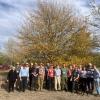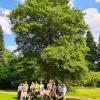Editor's Picks
Plant Focus
Project Contact: Tracy Cook, Director of Plant Conservation & Curation, Huntsville Botanical Garden, 4747 Bob Wallace Ave SW, Huntsville, AL 35805, USA.
Project Summary: TThe aims of the project are to count and georeference individual trees throughout Quercus boyntonii habitat, as well as assess their reproductive potential, collect and propagate acorns from a representative sample to safeguard important genetic diversity across the species’ range, and work diligently to slow the encroachment of invasive shrubs within the populations of the species.

Executive Summary: Boynton oak (Quercus boyntonii) is one of North America’s rarest oaks. It is endemic to central Alabama, where it is restricted to localized occurrences along sandstone outcrops within pine-oak-hickory forests. The obscurity of this rare oak cannot be overstated. Scientifically speaking, most of its natural history and ecology are still shrouded in mystery. This lack of knowledge is due in large part to the oak’s limited geographic distribution coupled with the fact that, without a trained eye, it can be a difficult oak to identify. However, if Boynton oak has a future, we must begin to fill in these knowledge gaps. Due to continued development around the Birmingham metropolitan area, Boynton oak, along with the myriad other species that share its habitat, are losing ground fast. Further complicating its loss of habitat is encroachment from other plant species. A combination of fire suppression and the introduction of invasive species like privet (Ligustrum sinense) have led to considerable habitat degradation and loss in recent decades. If actions aren’t taken now to preserve this species and its habitat, North America may lose one of its rarest oaks. Luckily, Boynton oak is one of the many oaks undergoing conservation planning by Botanical Gardens Conservation International’s Global Conservation Consortium for Oaks. Dedicated individuals representing botanical gardens, arboreta, and state and national conservation agencies are collaborating on a multifaceted effort aimed at both in-situ and ex-situ conservation for this tree. Huntsville Botanical Garden (HBG), in collaboration with the Auburn University’s Donald E. Davis Arboretum (AUDA), is working diligently to assess population sizes, safeguard this species in ex-situ living collections, and manage parts of its habitat. To that end, staff from both institutions count and georeference individual trees throughout Q. boyntonii habitat, collect and propagate acorns from a representative sample to safeguard important genetic diversity across the species’ range, and work diligently to slow the encroachment of invasive shrubs. Multifaceted efforts such as these are essential for the effective species conservation and to ensure that Boynton oak has a more secure future. Success of these conservation methods can be seen in more accurate estimates of population numbers across the range of this rare oak, increasing number of maternal lines represented in distributed ex-situ collections across eastern North America, and the maintenance of open areas of sandstone glades that maintain healthy living trees and provide new areas for successful seedling germination and growth. Ideally, we aim to maintain suitable habitat in one of the more degraded sites until a more holistic management plan can be developed, and collect a minimum of 12 maternal lines to increase the genetic diversity that has been captured.
Final Report: click here to download.
Further Reading
Keeping Tabs on Quercus boyntonii
Patrick Thompson
Species Spotlight: Quercus boyntonii
Emily Nichols and Patrick Thompson


















